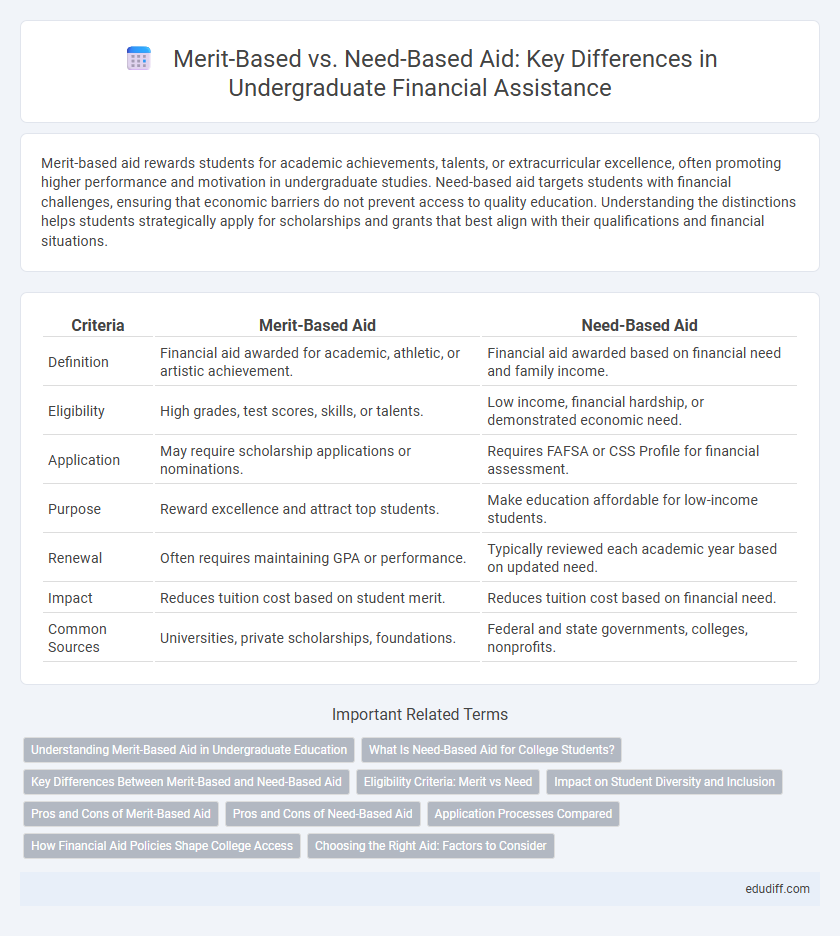Merit-based aid rewards students for academic achievements, talents, or extracurricular excellence, often promoting higher performance and motivation in undergraduate studies. Need-based aid targets students with financial challenges, ensuring that economic barriers do not prevent access to quality education. Understanding the distinctions helps students strategically apply for scholarships and grants that best align with their qualifications and financial situations.
Table of Comparison
| Criteria | Merit-Based Aid | Need-Based Aid |
|---|---|---|
| Definition | Financial aid awarded for academic, athletic, or artistic achievement. | Financial aid awarded based on financial need and family income. |
| Eligibility | High grades, test scores, skills, or talents. | Low income, financial hardship, or demonstrated economic need. |
| Application | May require scholarship applications or nominations. | Requires FAFSA or CSS Profile for financial assessment. |
| Purpose | Reward excellence and attract top students. | Make education affordable for low-income students. |
| Renewal | Often requires maintaining GPA or performance. | Typically reviewed each academic year based on updated need. |
| Impact | Reduces tuition cost based on student merit. | Reduces tuition cost based on financial need. |
| Common Sources | Universities, private scholarships, foundations. | Federal and state governments, colleges, nonprofits. |
Understanding Merit-Based Aid in Undergraduate Education
Merit-based aid in undergraduate education rewards students for academic excellence, leadership, or special talents, often requiring a high GPA or standardized test scores. These scholarships and grants do not depend on financial need but on demonstrated achievement, making them accessible to a wide range of students. Understanding merit-based aid helps students strategically enhance their applications to secure funding that recognizes their strengths and accomplishments.
What Is Need-Based Aid for College Students?
Need-based aid for college students is financial assistance awarded based on the student's or family's economic situation, aiming to make higher education accessible regardless of financial background. This aid includes grants, scholarships, work-study opportunities, and low-interest loans that are determined through the Free Application for Federal Student Aid (FAFSA) or institutional assessments. It targets reducing the financial burden by addressing the gap between the cost of attendance and the expected family contribution.
Key Differences Between Merit-Based and Need-Based Aid
Merit-based aid is awarded primarily based on academic, artistic, or athletic achievements, targeting students who demonstrate exceptional skills or talents. Need-based aid focuses on a student's financial situation, providing assistance to those with limited economic resources regardless of their academic performance. The key difference lies in the evaluation criteria: merit-based aid emphasizes merit and accomplishments, while need-based aid emphasizes economic necessity.
Eligibility Criteria: Merit vs Need
Merit-based aid is awarded primarily based on academic achievements, test scores, or extracurricular excellence, targeting students who demonstrate exceptional abilities or talents. Need-based aid focuses on a student's financial situation, assessing family income, assets, and expenses to determine eligibility for support. Understanding the distinct criteria for merit versus need-based aid helps students and families identify appropriate scholarships and grants aligned with their qualifications and financial circumstances.
Impact on Student Diversity and Inclusion
Merit-based aid often prioritizes academic achievements and standardized test scores, which can disproportionately favor students from higher socioeconomic backgrounds, potentially limiting diversity and inclusion. Need-based aid directly targets financial barriers, enabling students from underrepresented and low-income groups to access higher education, thereby enhancing campus diversity. Institutions that emphasize need-based aid tend to foster more inclusive academic environments, reflecting a broader range of socioeconomic and cultural perspectives.
Pros and Cons of Merit-Based Aid
Merit-based aid rewards academic achievement, leadership, or talent, motivating students to excel and often reducing tuition costs without requiring financial need verification. It provides opportunities for high-performing undergraduates but can overlook students with significant financial barriers who may not meet merit criteria. However, merit awards might encourage grade inflation or increased competition, potentially undermining collaboration and overall academic experience.
Pros and Cons of Need-Based Aid
Need-based aid provides crucial financial support to low-income undergraduate students, ensuring access to higher education regardless of economic background, but it often requires detailed documentation and can lead to limited funding availability. Eligibility for need-based aid fluctuates with changes in family income and assets, potentially causing unpredictability in financial planning. While it promotes equity by targeting resources to those most in need, some students may face stigma or challenges in meeting stringent application criteria.
Application Processes Compared
Merit-based aid applications typically require students to submit academic transcripts, test scores, and letters of recommendation showcasing achievements, while need-based aid emphasizes completing the Free Application for Federal Student Aid (FAFSA) or CSS Profile to verify financial need. Merit scholarships often have earlier deadlines and require separate scholarship applications, whereas need-based aid deadlines align with the general financial aid submission timeline. Understanding each process helps students maximize funding opportunities based on qualifications and financial status.
How Financial Aid Policies Shape College Access
Merit-based aid rewards academic, artistic, or athletic achievements, often increasing college access for high-performing students regardless of their economic background. Need-based aid targets students from low-income families, directly addressing financial barriers and promoting socioeconomic diversity on campus. These financial aid policies critically influence enrollment patterns by either widening access through targeted support or reinforcing existing inequalities based on merit criteria.
Choosing the Right Aid: Factors to Consider
Evaluating merit-based aid versus need-based aid requires assessing academic achievements, financial situation, and long-term education goals. Merit-based aid often rewards high GPA, test scores, or special talents, while need-based aid targets students with demonstrated financial need, ensuring affordability. Choosing the right aid involves balancing eligibility criteria, anticipated financial burden, and alignment with career aspirations to maximize educational funding.
Merit-Based Aid vs Need-Based Aid Infographic

 edudiff.com
edudiff.com